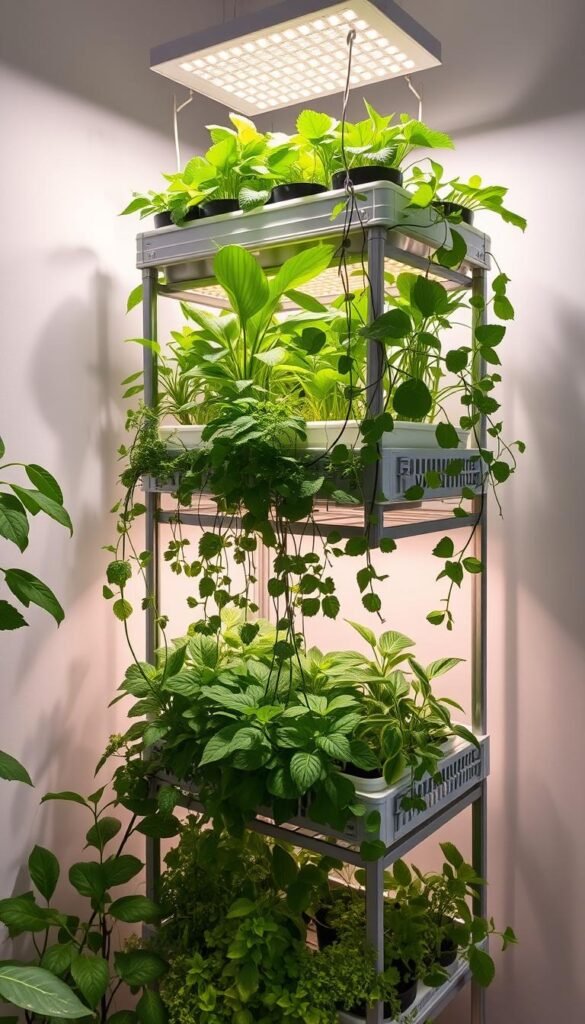Imagine harvesting crisp lettuce or juicy tomatoes from your kitchen counter – no dirt, weeds, or constant attention required. Today’s indoor garden setups use water-based growing methods to simplify plant care while delivering impressive results. These innovative solutions are perfect for urban dwellers craving homegrown flavors without the hassle.
What makes these smart growing systems stand out? Brands like AeroGarden and Gardyn build self-contained units with automated lighting schedules and reminders for adding nutrients. Their compact designs fit seamlessly into apartments or small homes, letting you grow herbs, vegetables, or flowers year-round.
Most models include LED grow lights optimized for photosynthesis and reservoirs that reduce watering frequency. Some even connect to smartphone apps for real-time updates – a game-changer for forgetful plant parents! For those new to soil-free gardening, our hydroponic system maintenance tips explain how to keep plants thriving with minimal effort.
Whether you want basil for weeknight pasta or strawberries for summer desserts, these systems adapt to your lifestyle. They’re designed to handle the technical details so you can focus on enjoying the harvest. Ready to discover how modern technology makes fresh produce accessible to everyone?
Introduction to Hydroponic Gardening
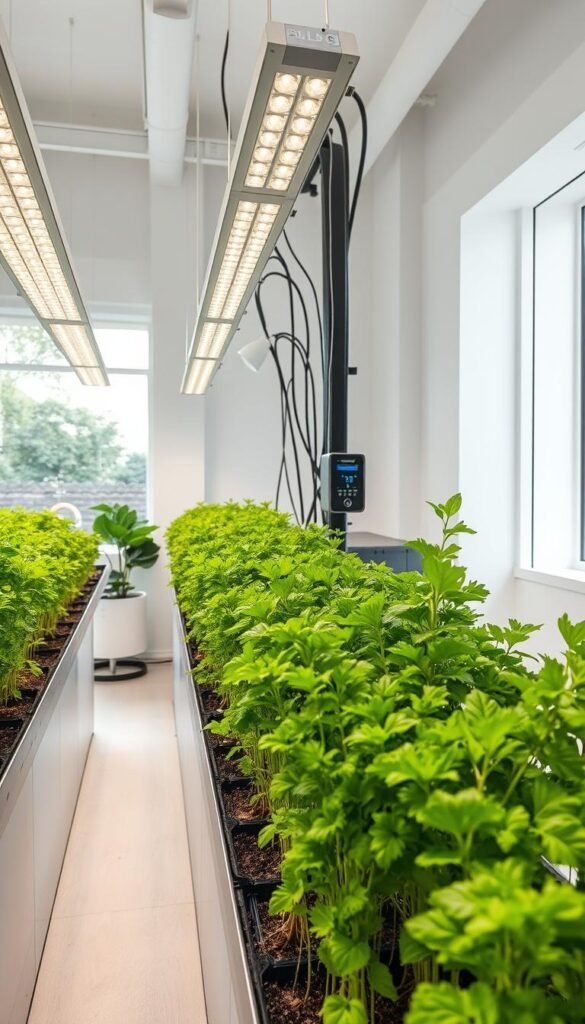
What if you could grow vibrant greens without ever touching soil? This revolutionary approach replaces dirt with nutrient-packed water, letting roots absorb essentials directly. Unlike traditional methods, there’s no weeding or guessing about soil quality – just pure plant power.
What Is This Soil-Free Method?
At its core, hydroponic gardening uses three key components:
- Water reservoirs that deliver liquid nutrients
- Circulation pumps maintaining oxygen flow
- Full-spectrum LED lights mimicking sunlight
These elements work together to create ideal growing conditions. Vegetables like kale and cherry tomatoes thrive in these controlled environments, often maturing 30% faster than their soil-grown cousins.
Perfect for Time-Crunched Plant Lovers
Why are urban growers switching? Modern systems handle the heavy lifting:
- Automatic reminders for adding nutrients
- Self-timing grow lights
- Compact designs fitting windowsills
You’ll spend minutes weekly checking pH levels instead of hours watering and weeding. It’s gardening simplified – fresh herbs for your meals without the constant upkeep traditional plots demand.
Benefits of Hydroponic Gardening for Your Home
Transform any sunny corner or empty shelf into a thriving garden that works smarter, not harder. Modern growing setups let you bypass seasonal limitations and spatial constraints, delivering fresh flavors even in studio apartments.
Faster Growth and Year-Round Harvests
Plants in water-based systems grow up to 30% quicker than soil gardens. Direct nutrient access means no energy wasted searching for food. LED grow lights provide consistent “sunlight,” letting basil reach full size in 3 weeks instead of 5.
| Method | Growth Speed | Harvest Frequency |
|---|---|---|
| Soil Gardening | 8-10 weeks | Seasonal |
| Hydroponic Setup | 5-7 weeks | Year-round |
Space Efficiency for Indoor Gardens
Compact vertical designs turn awkward nooks into productive zones. A 2-foot-wide unit can hold 12 plants – perfect for kitchen herbs like mint or oregano. Wall-mounted options keep counters clear while delivering daily salads.
Automated pumps and self-adjusting lights handle the science. You simply enjoy snipping parsley for omelets or garnishing drinks with homegrown thyme. It’s farming reinvented for city life.
Key Features to Look For in Hydroponic Systems
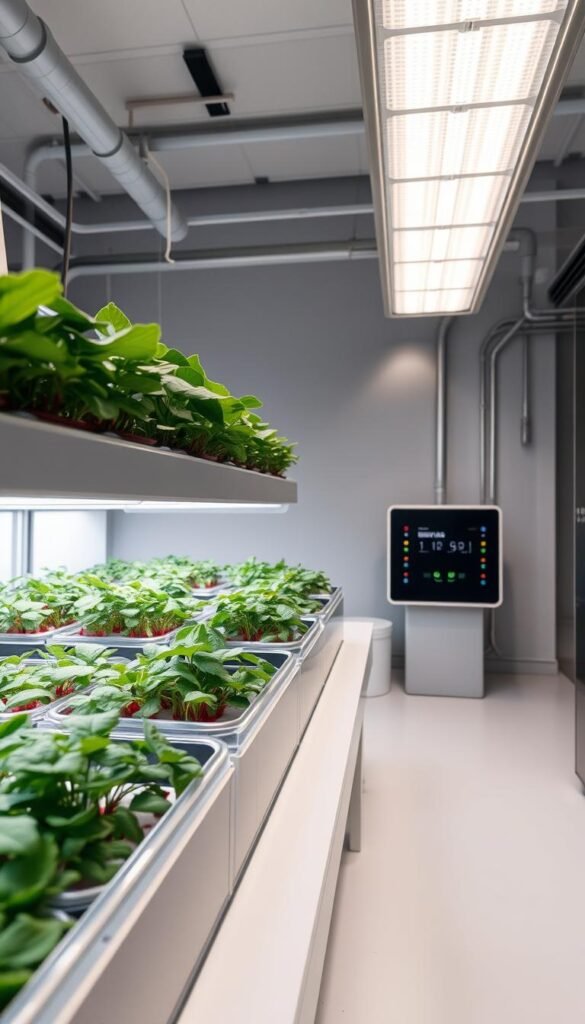
Ever wish your plants could practically take care of themselves? The best setups combine smart tech with beginner-friendly design. Let’s explore what separates “set it and forget it” systems from high-maintenance kits.
Automatic Watering and Lighting
Look for pumps with timers that water roots 3-5 times daily. These mimic natural rainfall patterns, keeping vegetables like peppers and greens perfectly hydrated. Pair this with adjustable LED schedules – most leafy herbs need 14 hours of light to grow quickly.
Advanced models sense water levels and refill reservoirs automatically. No more guessing if your basil needs a drink! This consistency helps seeds sprout faster and prevents mature plants from drying out.
User-Friendly Interfaces
Touchscreen controls and color-coded alerts make gardening accessible. Beginners love systems that flash when to add nutrients or check pH. Some even suggest recipes based on your harvest!
Pre-programmed modes handle different plant types. Want to grow strawberries alongside lettuce? The system adjusts light intensity and feeding cycles for each crop. If issues arise, our guide on troubleshooting common growing challenges helps you fix problems fast.
Whether starting with seeds or transplanting store-bought vegetables, choose a system that grows with your skills. The right features turn your kitchen into a self-sustaining farm!
Understanding Different Types of Hydroponic Systems
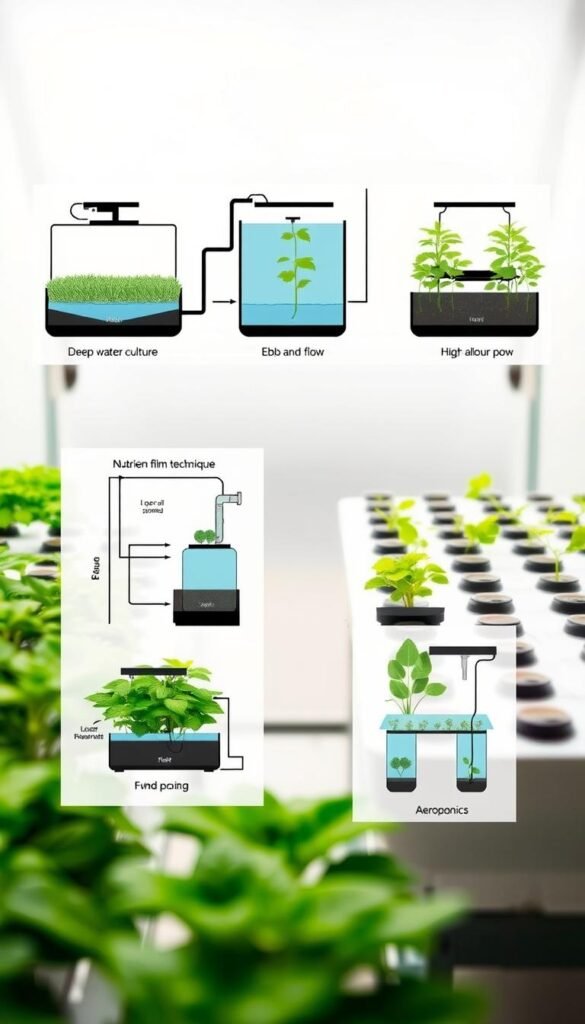
Choosing the right setup transforms how you grow fresh food at home. Let’s explore five popular methods that deliver nutrients efficiently while fitting different spaces and skill levels.
Deep Water Culture (DWC) and Nutrient Film Technique (NFT)
DWC systems suspend plant roots in oxygen-rich water. This method works wonders for lettuce and herbs, giving them constant access to nutrients. No pumps are needed – just an air stone to keep the water moving.
NFT setups use shallow streams to bathe roots. The flowing water prevents stagnation, making it ideal for leafy greens. Both systems use 20% less water than traditional gardening, perfect for home growers focused on sustainability.
Ebb and Flow, Drip, and Aeroponic Systems
Ebb and Flow systems flood roots periodically. This mimics natural rain cycles, encouraging strong growth in plants like strawberries. Drip systems target nutrients directly to each plant’s base – great for larger crops like peppers.
Aeroponics mist roots with nutrient spray. It’s the most advanced method, boosting growth rates by 45% compared to soil. While trickier to set up, it’s unbeatable for maximizing food output in tight spaces.
| System | Best For | Water Use | Maintenance Level |
|---|---|---|---|
| DWC | Lettuce, herbs | Low | Beginner |
| NFT | Leafy greens | Very low | Intermediate |
| Ebb & Flow | Fruiting plants | Moderate | Intermediate |
| Drip | Large vegetables | High | Advanced |
| Aeroponic | Fast-growing crops | Lowest | Expert |
For home chefs wanting daily salads, DWC or NFT systems shine. Those focused on diverse food production might prefer Ebb and Flow. Match your goals with these science-backed solutions!
Top Picks from Our Product Roundup
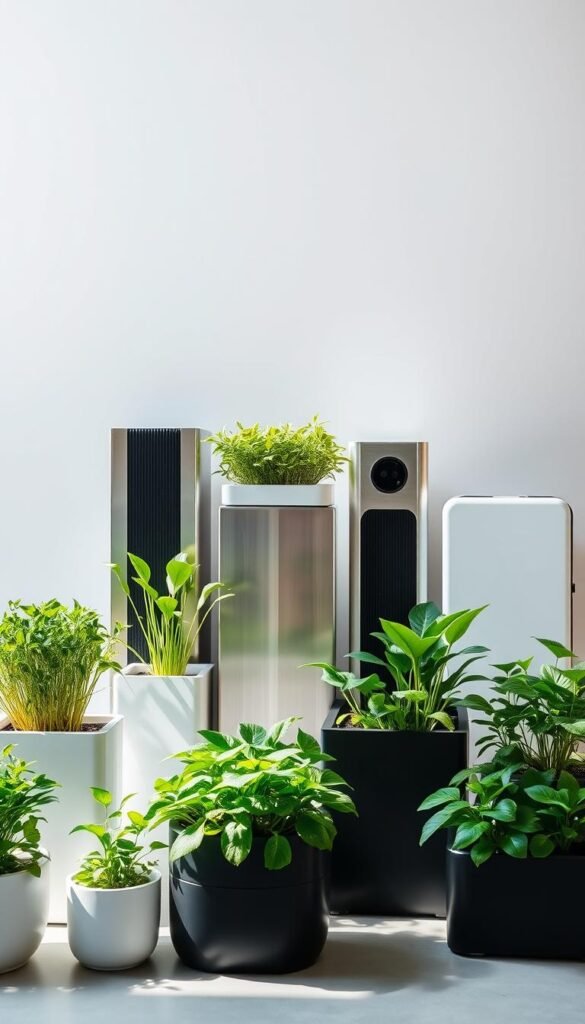
Discover the top-rated setups that make growing effortless. Our team tested popular models from leading brands to find reliable options that deliver fresh flavors with minimal fuss.
Brands You Can Trust
AeroGarden Harvest Elite shines for beginners with its 3-button control panel and adjustable LED arms. Users love its 12-pod capacity for growing cherry tomatoes alongside basil. Click & Grow Smart Garden 9 stands out with biodegradable plant pods and built-in water level indicators – perfect for those wanting to use eco-friendly materials.
For tech enthusiasts, Gardyn 3.0 offers vertical growing columns and a built-in camera that tracks plant progress. Real-world experience shows its app notifications reduce guesswork by 40% compared to manual systems.
Unique Selling Points of Each System
Compare key features at a glance:
| Model | Best For | Special Features |
|---|---|---|
| AeroGarden | Tomatoes & herbs | 30W LED, 1-gal reservoir |
| Click & Grow | Soil-free beginners | Self-watering base |
| Gardyn | Large harvests | AI plant diagnosis |
- Tomato specialists: AeroGarden’s nutrient mix helps fruit-bearing plants thrive without soil
- Space savers: Click & Grow’s 11-inch width fits narrow countertops
- Smart growers: Gardyn’s subscription service delivers new plant capsules monthly
These systems prove you don’t need gardening experience to enjoy homegrown food. Choose based on your kitchen space and favorite crops!
Low-Maintenance Hydroponic Systems for Busy Gardeners
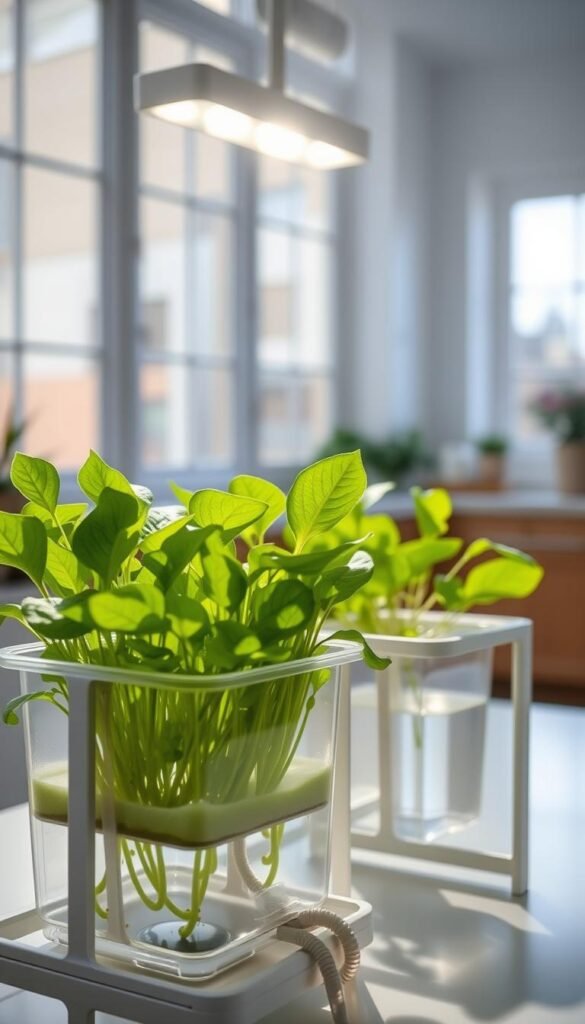
Starting your first garden shouldn’t feel like a part-time job. Modern setups remove guesswork through smart automation and clear instructions. Let’s explore how these tools help anyone cultivate fresh produce successfully.
Why They’re Ideal for Beginners
Beginner-friendly units feature preset programs for different plants. Automatic watering options maintain perfect moisture levels, while sensors alert you when to refill nutrients. LED grow lights run on timers, eliminating manual adjustments.
New users report success with these key features:
- Visual indicators for pH balance checks
- Pre-measured nutrient packets
- Error-proof seed pod designs
Real-World Examples and Reviews
Home growers share their experiences:
| System | Ease Rating | Top Crop | Watering Frequency |
|---|---|---|---|
| Gardyn Home | 4.8/5 | Sweet Peppers | Every 10 days |
| Click & Grow | 4.6/5 | Basil | Every 2 weeks |
| AeroGarden Harvest | 4.5/5 | Cherry Tomatoes | Weekly |
One Colorado user grew 15 peppers in 8 weeks using Gardyn’s AI-assisted system. “The app told me exactly when to add water,” they noted. Another reviewer praised Click & Grow’s soil-free pods for producing basil “twice as fast” as outdoor plants.
These options prove you don’t need green thumbs to enjoy homegrown flavors. Set up your unit, follow the alerts, and watch your plants thrive with minimal input.
Comparing Automated Versus Basic Hydroponic Kits
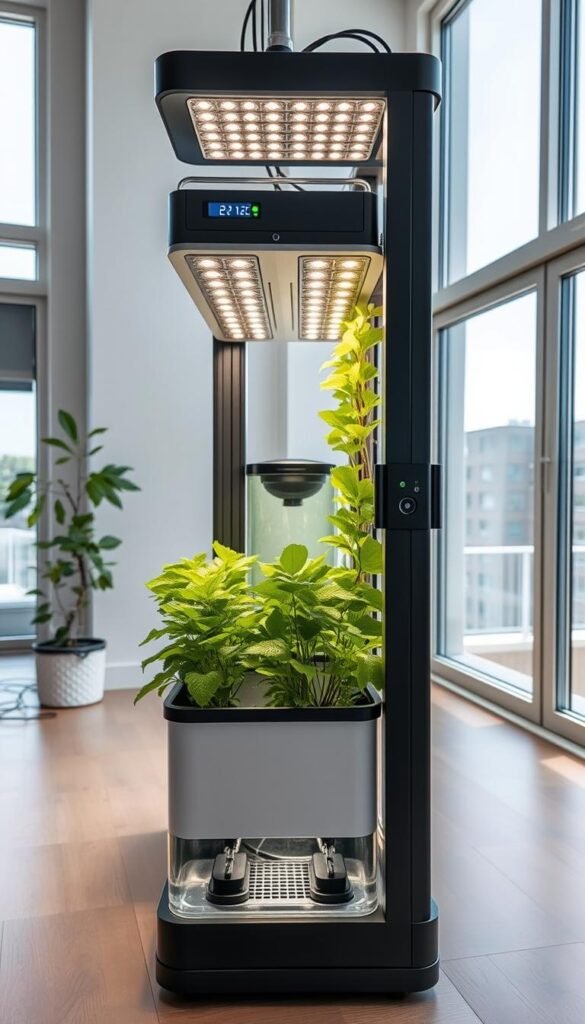
Ever wonder how much time you should invest in your indoor garden? Modern solutions range from app-connected marvels to straightforward plug-and-play units. Let’s break down which approach matches your lifestyle and growing goals.
Smart Technology and Connectivity Options
Automated kits like Gardyn 3.0 take the guesswork out of plant care. Built-in sensors track water levels and nutrient balance, sending push notifications when action’s needed. Their AI-powered grow lights adjust brightness based on plant growth stages – a feature that boosts yields by 25% in leafy greens.
Busy professionals love these systems. One Chicago user reported harvesting 18 heads of lettuce monthly with just 5 minutes of weekly maintenance. “The app reminds me to refill water every 12 days,” they shared. “It’s like having a gardening assistant.”
Simplicity and Ease of Setup
Basic systems like AeroGarden Harvest prioritize straightforward operation. Their manual controls appeal to those who prefer hands-on management. You’ll adjust grow lights and add nutrients yourself – perfect for learners mastering hydroponic gardening basics.
Compare key features:
| Feature | Automated Kits | Basic Systems |
|---|---|---|
| Maintenance Time | 2-3 hrs/month | 5-7 hrs/month |
| Learning Curve | Low | Moderate |
| Best For | Busy professionals | Hobbyist growers |
New York apartment dwellers often choose compact models like Click & Grow. Its soil-free pods eliminate measuring nutrients – just insert and water. While less techy, these hydroponic systems still produce herbs 50% faster than traditional pots.
Your choice depends on desired involvement. Want a self-sufficient growing system? Go automated. Prefer learning through doing? Start with manual controls and upgrade later.
Space-Saving Tips for Your Indoor Garden
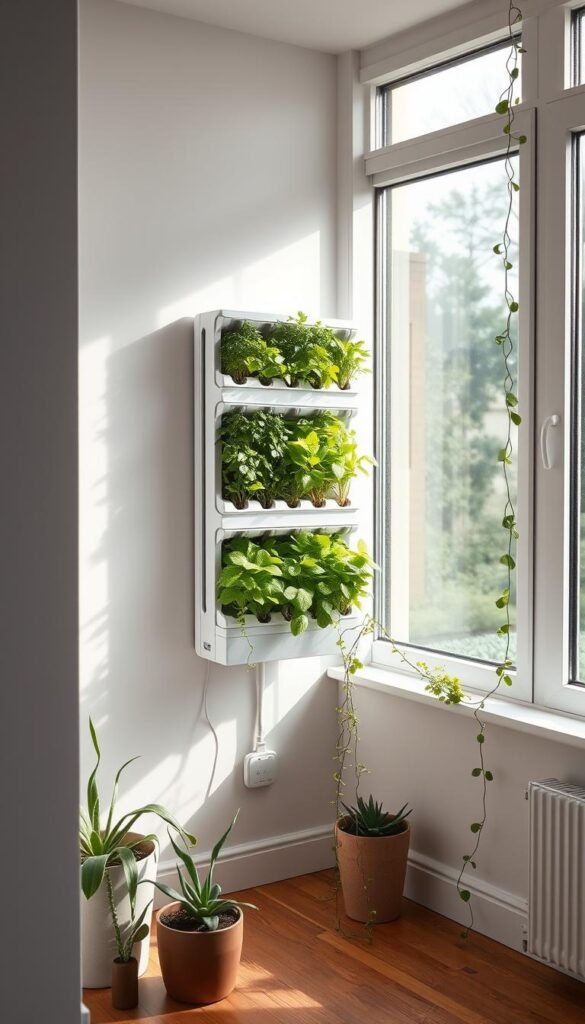
Maximizing your growing potential starts with smart spatial planning. Even the tiniest apartments can host lush greenery through strategic design choices. Let’s transform your limited space into a thriving edible oasis without sacrificing style.
Optimizing Your Available Area
Vertical arrangements double your planting real estate. Stackable hydroponic towers let you grow 18 plants in a 2×2-foot footprint – perfect for herbs like cilantro or mint. Pair these with wall-mounted LED grow strips that illuminate multiple tiers simultaneously.
Consider these space-enhancing strategies:
- Use corner shelves for triangular units that hug walls
- Install floating racks above windows for trailing plants
- Choose rectangular reservoirs over circular ones to fit tight spaces
Smart water management prevents waste in compact setups. Recirculating systems reuse nutrients, while drip lines deliver precise amounts to each plant. A Boston gardener reported 30% larger basil harvests after switching to vertical LED grow panels that distribute light evenly across stacked trays.
Balance form and function by matching your system’s size to your available space. Narrow countertop models (under 10 inches wide) work wonders for kitchen herbs, while taller units suit living room corners. Remember: proper airflow prevents mold in dense arrangements – leave 4-6 inches between plants for healthy growth.
Maintaining Your Hydroponic System with Minimal Effort
Keeping your plants thriving doesn’t have to be a daily chore. Modern setups simplify upkeep through smart design and clear maintenance cues. With a few weekly check-ins, you’ll prevent issues before they impact your harvest.
Nutrient Management and Cleaning Routines
Your indoor garden thrives when nutrients stay balanced. Check reservoir levels every 3-4 days using built-in indicators. Most beginners succeed by:
- Changing water solutions every 2 weeks
- Wiping grow trays during refills
- Using pH test strips weekly
Pre-mixed nutrient solutions save time and reduce measurement errors. For thorough cleaning, follow our cleaning and sterilizing guide to eliminate algae risks between crops.
Strategies to Prevent Common Issues
Clogged pumps and murky water won’t stand a chance with these tips:
- Flush tubing monthly with hydrogen peroxide solution
- Use opaque containers to block light from algae
- Trim overgrown roots during water changes
Automated systems often alert you to imbalances, but manual checks ensure nothing slips through. Pair these habits with proper airflow to keep plants disease-free. Your greens will reward you with faster growth and vibrant flavors!
Exploring Automated Features and Smart Gardening Tools
What if your garden could text you when it needs help? Advanced kits now use sensors and apps to handle routine tasks, letting you focus on enjoying fresh flavors. These innovations turn plant care into a hands-off experience while boosting growth rates.
How Automatic Alerts Enhance Your Experience
Smart systems like Gardyn’s 3.0 monitor water and nutrients 24/7. When levels dip, your phone buzzes with a reminder – no more wilted basil! Built-in pods track root health, adjusting light intensity to match each plant’s stage.
Real users report impressive results:
| System | Alert Types | Light Adjustment | Pod Capacity |
|---|---|---|---|
| Gardyn Home | Water, nutrients, pH | AI-powered | 30 plants |
| AeroGarden Harvest | Water & nutrients | Manual settings | 6 pods |
| Click & Grow | Water level | Fixed schedule | 9 pods |
These tools cut errors dramatically. One Texas gardener grew arugula 40% faster using light sensors that mimic dawn-to-dusk cycles. “My system waters plants at 5 AM,” they shared. “I wake up to perfectly hydrated greens.”
Embrace automation to simplify your routine. With kits handling the science, you’ll harvest vibrant crops while barely lifting a finger!
User Experiences and Practical Setup Advice
Real success stories prove hydroponics works beyond theory. Seasoned growers share how they turned initial challenges into abundant harvests through simple adjustments. Their journeys reveal what truly matters when starting your soil-free garden.
Learning From Seasoned Growers
A Seattle gardener transformed her balcony using a vertical system: “I check pH weekly and refill the reservoir every 10 days. My kale grows twice as fast compared to soil pots.” Like many gardeners, she emphasizes starting small – her 6-pod unit now supplies daily salads.
Common setup wisdom includes:
- Pre-soaking seeds in filtered water for faster germination
- Labeling nutrient bottles to prevent mixing errors
- Using aquarium thermometers to monitor water temperature
One Colorado family grows 15 herb varieties year-round. Their secret? “We clean the reservoir during crop rotations and test water quality every refill.” Their modular setup allows gradual expansion as skills improve.
| Challenge | Beginner Fix | Expert Solution |
|---|---|---|
| Algae growth | Cover exposed water surfaces | Install UV sterilizers |
| Root rot | Increase air pump power | Use hydroguard supplements |
| Slow growth | Adjust light height | Fine-tune nutrient ratios |
Transferring seeds to your system becomes effortless with practice. San Diego users recommend starting seedlings in rockwool cubes before placing them in net pots. “Our first cherry tomatoes took 9 weeks,” one noted. “Now we harvest in 6 by optimizing light cycles.”
Wrapping Up Your Hydroponic Adventure
Your journey into modern gardening doesn’t end here – it evolves. Soil-free growing lets you harvest fresh flavors while fitting design into any lifestyle. Whether you chose a countertop herb garden or vertical vegetable tower, the right setup becomes your partner in cultivating success.
Remember: Great results stem from smart foundations. Automated lighting and space-efficient layouts reduce daily tasks, while modular components let you expand as skills grow. One Minnesota gardener transformed their balcony into a year-round salad bar by tweaking their system’s design every season.
Don’t fear experimentation. Swap leafy greens for strawberries in your current setup, or test different nutrient mixes. Each adjustment teaches you more about plant needs and system capabilities. Many find joy in tracking growth patterns through app-connected tools that simplify learning curves.
As you refine your approach, celebrate small victories – that first homegrown pepper or fragrant basil bunch. These moments prove that efficient gardening thrives on curiosity and adaptability. Keep exploring, keep growing, and let your indoor oasis reflect your unique green-thumb style!

